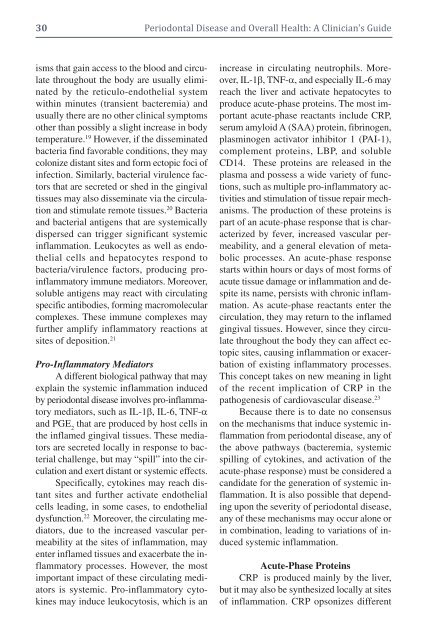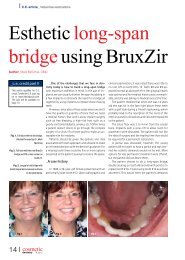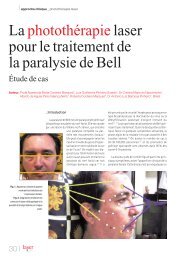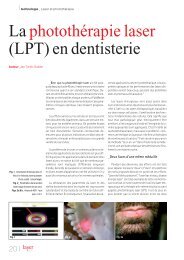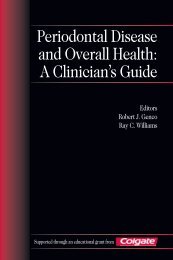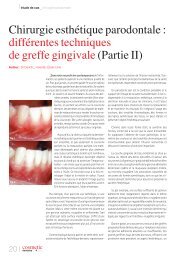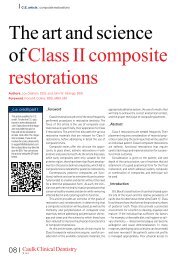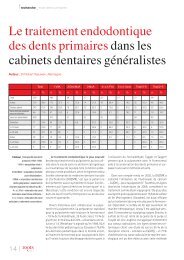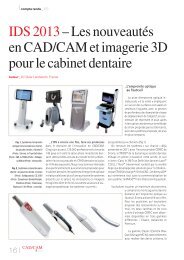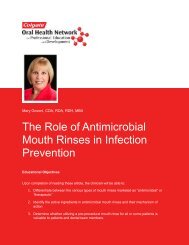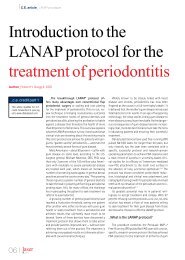Periodontal Disease and Overall Health: A Clinician's Guide
Periodontal Disease and Overall Health: A Clinician's Guide
Periodontal Disease and Overall Health: A Clinician's Guide
Create successful ePaper yourself
Turn your PDF publications into a flip-book with our unique Google optimized e-Paper software.
30 <strong>Periodontal</strong> <strong>Disease</strong> <strong>and</strong> <strong>Overall</strong> <strong>Health</strong>: A <strong>Clinician's</strong> <strong>Guide</strong>isms that gain access to the blood <strong>and</strong> circulatethroughout the body are usually eliminatedby the reticulo-endothelial systemwithin minutes (transient bacteremia) <strong>and</strong>usually there are no other clinical symptomsother than possibly a slight increase in bodytemperature. 19 However, if the disseminatedbacteria find favorable conditions, they maycolonize distant sites <strong>and</strong> form ectopic foci ofinfection. Similarly, bacterial virulence factorsthat are secreted or shed in the gingivaltissues may also disseminate via the circulation<strong>and</strong> stimulate remote tissues. 20 Bacteria<strong>and</strong> bacterial antigens that are systemicallydispersed can trigger significant systemicinflammation. Leukocytes as well as endo -thelial cells <strong>and</strong> hepatocytes respond tobacteria/virulence factors, producing proinflammatoryimmune mediators. Moreover,soluble antigens may react with circulatingspecific antibodies, forming macromolec ularcomplexes. These immune complexes mayfurther amplify inflammatory reactions atsites of deposition. 21Pro-Inflammatory MediatorsA different biological pathway that mayexplain the systemic inflammation inducedby periodontal disease involves pro-inflamma -tory mediators, such as IL-1, IL-6, TNF-<strong>and</strong> PGE 2that are produced by host cells inthe inflamed gingival tissues. These mediatorsare secreted locally in response to bacterialchallenge, but may “spill” into the circulation<strong>and</strong> exert distant or systemic effects.Specifically, cytokines may reach distantsites <strong>and</strong> further activate endothelialcells leading, in some cases, to endothelialdysfunction. 22 Moreover, the circulating mediators,due to the increased vascular permeabilityat the sites of inflammation, mayenter inflamed tissues <strong>and</strong> exacerbate the inflammatoryprocesses. However, the mostimportant impact of these circulating mediatorsis systemic. Pro-inflammatory cyto -kines may induce leukocytosis, which is anincrease in circulating neutrophils. Moreover,IL-1, TNF-, <strong>and</strong> especially IL-6 mayreach the liver <strong>and</strong> activate hepatocytes toproduce acute-phase proteins. The most importantacute-phase reactants include CRP,serum amyloid A (SAA) protein, fibrinogen,plasminogen activator inhibitor 1 (PAI-1),complement proteins, LBP, <strong>and</strong> solubleCD14. These proteins are released in theplasma <strong>and</strong> possess a wide variety of functions,such as multiple pro-inflammatory activities<strong>and</strong> stimulation of tissue repair mechanisms.The production of these proteins ispart of an acute-phase response that is characterizedby fever, increased vascular permeability,<strong>and</strong> a general elevation of metabolicprocesses. An acute-phase responsestarts within hours or days of most forms ofacute tissue damage or inflammation <strong>and</strong> despiteits name, persists with chronic inflammation.As acute-phase reactants enter thecirculation, they may return to the inflamedgingival tissues. However, since they circulatethroughout the body they can affect ectopicsites, causing inflammation or exacerbationof existing inflammatory processes.This concept takes on new meaning in lightof the recent implication of CRP in thepathogenesis of cardiovascular disease. 23Because there is to date no consensuson the mechanisms that induce systemic inflammationfrom periodontal disease, any ofthe above pathways (bacteremia, systemicspilling of cytokines, <strong>and</strong> activation of theacute-phase response) must be considered ac<strong>and</strong>idate for the generation of systemic inflammation.It is also possible that dependingupon the severity of periodontal disease,any of these mechanisms may occur alone orin combination, leading to variations of inducedsystemic inflammation.Acute-Phase ProteinsCRP is produced mainly by the liver,but it may also be synthesized locally at sitesof inflammation. CRP opsonizes different


